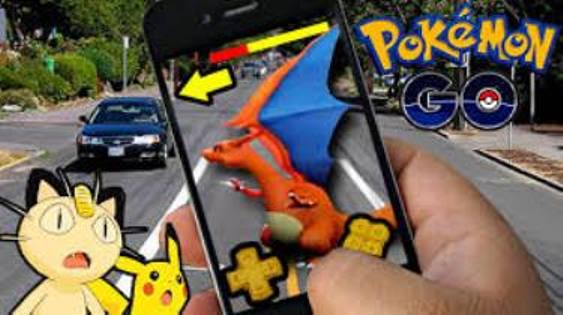Category Archive: Parents

Pokémon Hunting Presents Real Dangers
July 11, 2016
After its release less than a week ago, the new Pokémon Go app for smart phones has rapidly gone viral and is taking the world by storm. Just like with any big storm, we can expect a lot of injuries and, unfortunately, some deaths.
If you’ve been wasting your time over the last five days paying attention to the elections in the US and Great Britain or other world events, you may not know what all this Pokémon hoopla is all about. Pokémon Go is a smartphone app that allows its users to hunt for and capture Pokémon cartoon characters in a real world environment. The free app uses the phone’s camera feature to blend the Pokémon world with the real world around you. The best way to understand it is to imagine a virtual scavenger hunt.
Those who complain that their kids are spending too much time indoors playing video games might appreciate the fact that, in order to play this game, the player has to go outside and wander the neighborhood to find Pokémon. The aim is to catch as many Pokémon as possible to earn points and get promoted to different levels. Users can also join teams and work with other team members to accumulate points.
According to news reports and social media, the game is quickly becoming addictive and, during the first 24 hours after its release, it was downloaded more than the dating app Tinder. According to SimilarWeb, the number of daily users has already equaled that of Twitter.
The problem with this game is that, in order to find and capture Pokémon, the user will have to pay attention to the screen at all times. Once a Pokémon is found, the user has to aim and fire the capture device with enough velocity to capture the creature.
This means that a lot of people are going to be wandering around with their eyes focused on their smartphone rather than the path ahead. Drivers are going to have to be even more alert for distracted pedestrians stepping into the roadway. Team members who are afraid of falling behind may be tempted to continue playing the game even when they’re behind the wheel. To play the game effectively, the player will have to pay more attention to the screen than to the road ahead.
The Pokémon Go website carries the following warnings:
- “For safety’s sake, never play Pokémon Go when you’re on your bike, driving a car, riding a hoverboard, or anything else where you should be paying attention, and of course never wander away from your parents or your group to catch a Pokémon.”
- “If you see a Pokémon someplace where it might not be safe to capture it (like in a construction site or on private property that you can’t get to from the street), don’t do it. There will always be another chance to catch that Pokémon later on!”
In Missouri, a team of armed robbers waited for victims at a remote Pokémon spot. Already, accounts of cuts, bruises, and twisted ankles are showing up online. It’s just a matter of time before the first player is hospitalized or killed.

The Deadliest Period For Teen Drivers
June 8, 2016
The recent Memorial Day weekend began the deadliest period of the year for teen drivers. Known as the “deadliest 100 days,” the period between Memorial Day and Labor Day has, for many years, seen a significant rise in the deaths of teen drivers and their passengers.
The fatality increase during the summer months is due to several factors:
- Teens are out of school with extra time on their hands.
- Teens are bored and looking for excitement.
- Teens often fail to pace themselves – spending all day doing physically taxing activities at the beach and then going out late into the night.
- Alcohol or other drugs are often a part of the summer activities.
One might think that inexperience behind-the-wheel would also play a major role in the summer death rate and it does to an extent however, teens with the least experience have a much lower death rate than teens that have been driving a few years. Among Florida teen drivers aged 15 through 20 killed in 2014, drivers aged 15 through 17 made up only 12 percent of the teen deaths. Teen drivers aged 18, 19, and 20 accounted for 88 percent of the teen deaths during the deadliest period.
The death rate among older teens may be due to the fact that the older teens, after getting over the initial fear of solo driving become less cautious and more complacent. Another reason is that restrictions imposed on younger drivers by Graduated Driving Laws (GDL) are generally lifted by age 18 and teens who exercised caution during their probationary driving periods have now thrown caution to the wind.
Another issue that adds to the deadliest period is that of driver distractions. When discussing driver distractions, most automatically think of cell phones and texting. Those are serious and dangerous distractions but, surprisingly, they aren’t the distractions that contribute to most teen crashes. The AAA Foundation for Traffic Safety recently published the results of a study that used video cameras to follow 1,691 teen drivers for five years. During that period, the study subjects experienced a total of 538 crashes. While distractions by cell phones led to 12 percent of the crashes, distractions by talking to and interacting with teen passengers led to 15 percent of the crashes.
Teen passengers are a major distraction for teen drivers and that’s why many states restrict the number of passengers a teen driver can carry under their GDL laws. The lifting of both cell phone and passenger restrictions at age 18 is probably a major factor for the deaths among older teens during the deadliest period.
No matter what state law may say, parents can still impose their own driving restrictions on teens. Parents can limit the number of passengers to reduce distractions and they can ban the use of cell phones while driving. Parents who set the example by limiting their own use of cell phones and other distracting behaviors while driving stand the best chance of getting their teens to obey the rules.

Some Teen Safe Driving Choices Are Still Dangerous
December 17, 2015
Researchers at the Children’s Hospital of Philadelphia recently conducted a study to gauge teen attitudes on safe driving choices regarding cell phones. The researchers saw some encouraging signs but say there’s still a long way to go before cell phone use by teens while driving is a thing of the past.
To conduct their research, the researchers conducted several focus groups with 16 to 18 year old drivers. The questions asked of the teen drivers were designed to get an overall view of teen perceptions regarding cell phone use while driving with the intent of gathering information to help develop future interventions to reduce risky driving choices by teens.
According to the head researcher, Catherine McDonald, PhD, RN, it was encouraging to see that teens recognized that cell phone use, texting, and use of social media are dangerous behind-the-wheel. When asked what methods teens used to prevent the use of cell phones while driving, some teens listed methods such as turning off the cell phone or pulling off the road before making or answering a call. However, some teens listed choices such as waiting for a red light or until they were on familiar roads before diverting their attention to the cell phone.
While it’s good that they are considering ways to reduce their cell phone use, those choices such as waiting for red lights or familiar roads are still dangerous choices that take their eyes and mental attention off the road.
- Choosing to use hands-free communication devices has been shown to be no safer than the use of hand-held devices.
- A driver’s attention at red lights is important too. Not noticing that the light has turned green can hold up traffic behind and lead angry drivers to try to retaliate.
- Research shows that hands-free devices are still distracting for up to 27 seconds after hanging up.
- Waiting for familiar roads is a bad choice because most traffic collisions happen within 25 miles of home and at speeds below 45 mph. Drivers become complacent on those familiar roads and that leads to even more distractions.
According to the researchers, until more effective methods are developed to pry teens away from their cell phones while driving, parents are still the primary influence in promoting safer choices by teens. Setting a good example and insisting on strict rules for cell phone use while driving, parents can help keep their teens safe on the road.
Parents Don’t Understand The Dangers Of Teen Driving
December 3, 2015
A father’s grief following the death of his 17 year old son in a single car crash led him to write a book and produce a video to warn parents about the dangers of teen driving. The father, Tim Hollister, published his book Not So Fast: Parenting Your Teen Through the Dangers of Driving in 2013 and released the companion video on the ninth anniversary of his son’s death.
Teen drivers die at a disproportionate rate compared to all other age groups. In 2013, 1,691 teen drivers were killed and 177,000 were injured in car crashes. An additional 2,642 passengers, occupants of other vehicles, and pedestrians were killed in crashes involving a teen driver.
We have written articles on the dangers cited by Hollister countless times in this and other blogs but teens keep dying the same way month after month. Despite all the training and testing, teens die;
- Because their brains aren’t yet fully developed, leading them to take greater chances with no regard for the consequences.
- Most often in single vehicle crashes after losing control of their vehicle while speeding or driving distracted.
- While carrying other teen passengers who act as a distraction and whose presence, in some cases, lead the teen driver to show off by disregarding the safe driving rules.
- After drinking or using drugs.
- Because they text and drive with the belief that nothing bad will happen to them.
- Because they fail to wear seat belts.
Maybe, what it will take to get the word out to parents is the advice of a grieving father who knows now what he wishes he had known while his son was still alive.
The most important message is to not rely on driver’s ed, state tests, or common sense to keep your teen alive on the road. Parents must be constantly vigilant and set strict rules for their teen driver if they want them to survive into adulthood.
For more information visit: Not So Fast: Parenting Your Teen Through the Dangers of Driving

“5 to Drive” Rules To Keep Teen Drivers Safe
October 23, 2015
It’s Teen Driver Safety Week and this year’s theme is “5 to Drive”, referring to five things teen drivers need to be aware of when they drive. The five things are practices by teens that are the most common cause of teen crashes or that increase the chances of greater injury or death in a crash. The five rules that teens must obey if they want to live through a trip on the road are:
- No alcohol
- No cell phone use while driving
- No driving or riding without wearing a seat belt.
- No speeding.
- No extra passengers.
We’ve written about most of these before in a column on the most common type of teen crash. The only thing not covered in that column was the extent to which alcohol and other drugs contribute to teen crashes.
While alcohol use by teens has gone down significantly over the past few years, it still plays a big role in teen crashes. Of all the teen drivers (ages 15-20) killed in 2013, 29 percent had a BAC level of .01 or higher. Among those killed with measurable amounts of alcohol in their system, 82 percent had a BAC level of .08 or higher. More and more research studies show that other drugs along with alcohol are also showing up among drivers involved in crashes.
Cell phones, whether they’re being used for phone calls, texting, or social networking, present a significant danger to drivers of all ages but are especially dangerous for inexperienced teen drivers. Studies show that even hands free cell phone use is distracting.
Among young people aged 16-20 killed in crashes in 2013, more than half (55%) weren’t wearing seat belts. Fifty percent of the teen drivers killed in 2013 were unrestrained. Among teen drivers who survived a fatal crash, 85 percent were wearing seat belts. Studies show that teens who might otherwise wear a seat belt when driving themselves, don’t wear seat belts when riding as a passenger of another teen driver.
Speeding is responsible for approximately one-third of all fatal crashes in the US every year. For drivers under the age of 20 who were involved in fatal crashes, 35 percent of the males and 21 percent of the females were speeding. Speeding reduces the time a driver has to react to an emergency situation ahead and it increases the crash forces. Many teens learn, to their horror, that it’s impossible to keep a speeding car on the road in a curve.
Cell phones aren’t the only distraction for teen drivers. According to a 2012 study by the AAA Foundation For Traffic Safety, a teen driver’s risk of involvement in a deadly crash increases by 44 percent with one teen passenger in the vehicle. The risk doubles with two teen passengers and quadruples with three or more passengers. A teen driver is more likely to engage in risky behavior when one or more teen passengers are present.
Graduated driving laws were created to give teen drivers extra time to gain more driving experience by outlawing the five practices that contribute to so many teen crashes. However graduated driving laws for teens aren’t equal in all states. Parents should be aware of the laws in their state and, if their state’s graduated driving laws don’t go far enough to limit the distractions that teens face, parents can enact their own graduated driving license laws through the use of a teen driving contract.
